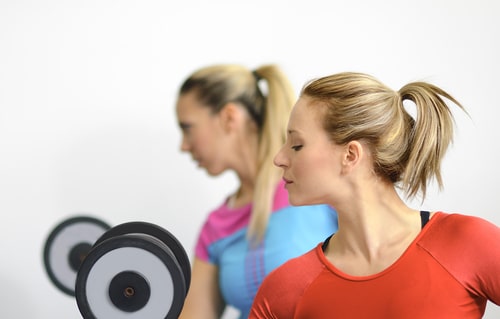 One of the benefits of intense exercise is it continues to burn fat at a higher rate even after you stop. This phenomenon of excess post-exercise oxygen consumption (EPOC) is sometimes referred to as the afterburn. Why do you experience it? Your body has to burn more calories to recover from a high-intensity workout. The extra calories are used to compensate for oxygen deficits, remove lactate, resynthesize ATP and lower body temperature by boosting circulation. The afterburn is a well-described phenomenon after high-intensity aerobic exercise and is greatest at intensities of 80% of maximal heart rate or greater. In other words, a walk in the park isn’t going to give you an afterburn. What’s less clear is whether resistance exercise increases EPOC to the same degree as high-intensity aerobic workouts.
One of the benefits of intense exercise is it continues to burn fat at a higher rate even after you stop. This phenomenon of excess post-exercise oxygen consumption (EPOC) is sometimes referred to as the afterburn. Why do you experience it? Your body has to burn more calories to recover from a high-intensity workout. The extra calories are used to compensate for oxygen deficits, remove lactate, resynthesize ATP and lower body temperature by boosting circulation. The afterburn is a well-described phenomenon after high-intensity aerobic exercise and is greatest at intensities of 80% of maximal heart rate or greater. In other words, a walk in the park isn’t going to give you an afterburn. What’s less clear is whether resistance exercise increases EPOC to the same degree as high-intensity aerobic workouts.
Resistance Exercise and EPOC
Fewer studies have looked at EPOC after resistance training, but the ones that have suggested that resistance training does boost EPOC.
In one study, researchers compared EPOC with three different exercise protocols: circuit training using resistance, aerobic cycling, and heavy resistance training. The aerobic cycling group cycled for 40 minutes at 80% of their heart rate max, while the circuit training group did 4 sets of 8 exercises (15 reps) at 50% of their one-rep max at a resistance equivalent to 50% of their one-rep max. The heavy resistance group did 3 to 8 reps of 8 exercises at 85% of their one-rep max.
The results? The heavy resistance group had the greatest EPOC or afterburn. Another study that compared resistance training to moderate-intensity exercise found that EPOC was greatest after resistance training.
Resistance Train to Boost Your Metabolism
Lots of people think the way to boost their metabolism is to do aerobic exercises like running and cycling, but you may get more fat-burning “bang for your buck” by focusing on heavy resistance training. Not only does resistance training give a significant afterburn, meaning you burn more calories even after you finish working out, it also builds lean body mass. Lean body mass is more metabolically active and having more of it increases the number of calories you burn when you’re walking around or resting.
To get a significant afterburn from resistance training, use a resistance that’s challenging. Choose 8 exercises with an emphasis on ones that recruit large muscles and multiple muscles at the same time like squats, bench press, push-ups, deadlifts or rows. Do 3 sets of 6 to 12 reps of each exercise with 1 to 3 minutes rest between sets. The weight should be challenging enough that you have to struggle to do the last rep with good form.
What Does This Mean?
If you’re trying to lose weight and you’re stuck in “cardio” mode, increase the intensity of your cardio workout and cut back on the amount of time you do it. Use that extra time to focus on resistance training. Resistance training may burn fewer calories than an aerobic workout while you’re doing it, but it gives an afterburn and builds more metabolically-active lean body mass. Making a change like this can also help you break out of a weight loss plateau and start seeing results again.
References:
IDEA Health and Fitness Association. “Exercise After-Burn: A Research Update”
Sports Medicine, 33 (14), 1037–60.
Related Articles By Cathe:
These Are the Two Biggest Factors that Determine How Much of an Afterburn You Get
Are There Legitimate Ways to Boost Your Metabolism?
Is the Afterburn Effect You Get after a Strength Workout Overrated?
Does Strength-Training Really Boost Your Metabolism?
6 Ways to Burn More Calories When You Weight Train
What’s the Best Weight-Training Approach for Fat Loss?
5 Common Mistakes You’re Making When Exercising to Lose Weight
Related Cathe Friedrich Workout DVDs:
STS Strength 90 Day Workout Program
All of Cathe’s Strength & Toning Workout DVDs
Total Body Workouts
Lower Body Workouts
Upper Body Workouts

